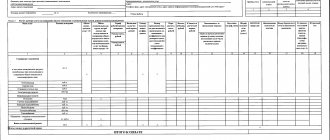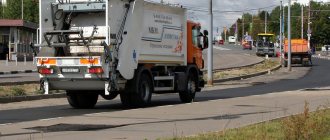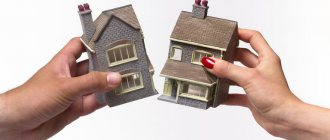“HVS ODN” - decoding
When receiving a monthly payment receipt, the first thing that may confuse you is the abundance of abbreviations that are incomprehensible to someone who has just begun to delve into the details of utility charges.
“HVS ODN” and “DHW ODN” are the consumption of resources for general house needs (GVS) for cold water supply (CWS) and hot water supply (DHW).
As a rule, the consumption of cold water supply exceeds the consumption of hot water. This is due to the fact that cold water is the main water supply in an apartment building, and hot water is obtained by heating cold water and is supplied in the volume that is necessary to obtain the desired temperature.
Heating occurs using heating devices that raise the water temperature to 60-75°C, after which house pumps supply water through pipelines to apartments and other places of household consumption.
Due to the fact that obtaining hot water requires additional resources in the form of heating and supply to apartments, its cost is usually higher than the cost of cold water supply.
Calculation of the cost of water disposal at one water pumping station
Of course, most of the disagreements concern cases where an apartment building is equipped with communal meters for hot and cold water supply, but is not equipped with a specialized communal metering device for sewerage utilities. And there are a huge number of such houses in the Russian Federation.
In addition, resource supply organizations refer to the Federal Law of December 7, 2011 No. 416-FZ “On Water Supply and Water Disposal”, according to clause 11 of Article 20 of which, if the subscriber does not have a wastewater meter, the volume of wastewater discharged by the subscriber is assumed to be equal to the volume of water supplied to this subscriber from all sources of centralized water supply, taking into account the volume of surface wastewater if the receipt of such wastewater into the drainage system is provided for by the drainage agreement. This document came into force on 01/01/2013 and regulates relations in the field of water supply (preparation, transportation and supply of drinking or hot water to subscribers using centralized or non-centralized cold or hot water supply systems, respectively) and wastewater disposal (reception, transportation and wastewater treatment using centralized drainage system).
We recommend reading: How long does it take to file a lawsuit for non-payment of utilities?
What is included in the ODN for cold water?
The water tax rate includes the consumption of resources consumed for the maintenance and servicing of the common areas of the house. Such territories include both the interior space (entrances of the house, utility rooms, attics and basements) and the external territory adjacent to the house (yard, parking lot, additional buildings).
A typical example of general house water consumption could be the consumption of water for wet cleaning of entrances or for watering flower beds located on the territory of the house.
Read more about what ODN is
Is it legal to charge one for wastewater disposal in 2020?
Federal Law No. 258-FZ dated July 29, 2020 “On Amendments to Articles 154 and 156 of the Housing Code of the Russian Federation and Article 12 of the Federal Law “On Amendments to the Housing Code of the Russian Federation and Certain Legislative Acts of the Russian Federation” was adopted.
According to the adopted amendments, the payment for the single-metering device will now still be charged according to the standards, however, if the house has communal metering devices, then periodically (most likely once a year) the payment for the single-metering device will be recalculated according to the readings of the communal metering devices (Part 9.2 of Art. 156 Housing Code of the Russian Federation).
07 Feb 2020 juristsib 3879
Share this post
- Related Posts
- Directions Military Pension
- Tax benefits for Chernobyl victims in 2020
- Benefit for the Third Child in 2020 in St. Petersburg
- Legalize Apartment Redevelopment in 2020 ECB
Do I need to pay for communal water needs?
ODN for water is paid by apartment owners. Such regulations are prescribed in Government Decree No. 354.
The consumer of utilities in an apartment building, regardless of the chosen method of managing the apartment building, as part of the payment for utility services, separately pays for utilities provided to the consumer in residential or non-residential premises, and for utilities consumed during the use of common property in an apartment building home (hereinafter referred to as utilities provided for general house needs). “Rules for the provision of utility services to owners and users of premises in apartment buildings and residential buildings”, Decree of the Government of the Russian Federation dated May 6, 2011 No. 354
Thus, the accrual of ODT for water is completely legal on the part of the management company.
All about ODN from July 2020
Thus, the adoption of the new law makes it possible to ensure the correctness and transparency of accruals; people, and even the management companies themselves, will be interested in installing communal metering devices. In addition, when owners have fewer questions regarding the ODN accrual system, the amount of money lost by resource supply organizations should decrease significantly.
Today it is too early to talk about a complete resolution of this issue. Many homes are not yet equipped with appropriate accounting systems, although people have long understood their importance and necessity. Meters make it possible to ensure transparency in the calculation of single tax payments and eliminate the possibility of unjustified overpayments. In addition, practice has shown that payment according to established standards is much higher than according to indicators of accounting systems.
We recommend reading: Benefits for low-income families in 2020 in St. Petersburg
How is ODN calculated for water?
Unlike apartments, common areas are not equipped with individual metering devices (IMU), and therefore water consumption for common house needs is recorded only by a common building meter (ODMU).
When calculating the ODN payment for water in an apartment building, the readings of the common building meter are first taken. It shows how much total water was consumed within the home during the reporting period.
Next, the readings of the residents’ individual metering devices are collected and summarized. In order for the house balance to be compiled correctly, the IPU readings must be taken at the same time.
Typically, several days are allotted for collecting readings from residents, but today manual collection of readings is increasingly giving way to automated collection of readings, which makes the collection process as one-time as possible, which increases the accuracy of the balance for the house.
Unlike manual reading collection, which takes a week to collect and process all the readings, automated reading collection allows you to consolidate your home data in just 15 minutes.
After the IPU readings are collected, their amount is subtracted from the readings of the general building meter. The difference that results is usually considered an expense for general household needs.
A simple example: a communal meter showed the consumption of 4,000 m³ of water during the reporting period. The total readings from individual metering devices amounted to 3,800 m³. The resulting difference of 200 m³ is the amount of water that was spent on the maintenance and maintenance of common areas - for wet cleaning in the entrance, watering the flower beds on the territory, etc.
How is the ODN standard for electricity calculated and what is its size in 2020?
Over the past month, the Energonadzor hotline has received many calls from indignant residents living in an apartment building - as a result, in January, payments for ODN in relation to electricity consumption increased by 4, or even 6 times. The differences in payment are significant, in one region there is more, in another less, and this is understandable - the standards are set by the regional administration of each individual subject of the Russian Federation.
- lighting of staircases, vestibules, entrances;
- electricity necessary for uninterrupted operation of intercoms;
- electricity consumed by elevator cabins;
- electricity for video cameras, if they are installed in the house;
- technological losses recorded in intra-house networks.
We recommend reading: Is it possible to get a mortgage without a down payment in 2020
Tariffs for general house needs in an apartment building from January 1, 2020
Regulatory legal acts that relate to general household needs are established by the regional authorities; accordingly, different regions may have different standards. But in any case, residents must pay only existing standards.
The remaining amount is distributed to office premises, stairs, elevators and for the general functioning of equipment in the house. Therefore, light in almost every house is used around the clock, despite the fact that the residents themselves can save on their living space.
We recommend reading: Cash Subsidy Calculator for Military Personnel in 2020
What is sewerage in a utility bill receipt?
In the event of the death of a Chernobyl survivor, the widow has the right to receive benefits. Large families, according to Russian legislation, are considered families raising three or more children. This category of citizens has the right to receive a discount on housing and communal services payments of at least 30%. Veterans of labor citizens who have earned this distinction can count on a reduction in the total cost of receipts by 50%.
Employees of budgetary institutions living in rural areas, benefits provided to this category of citizens are provided at the regional level and in some even reach 100%. Low-income people in some regions have their own programs to support citizens in difficult financial situations.
Utility resources for the maintenance of common property
The work necessary to maintain the operational characteristics of the common property of the apartment building is carried out on the house constantly and at established intervals, which means constant consumption of utility resources.
Until 01/01/2020, property owners could pay the cost of utilities for general house consumption (hereinafter referred to as GDN), based on the readings of a common house meter. To do this, it was necessary to make a decision at a general meeting.
We recommend reading: List of Documents for Low-Income Families for Social Security for Confirmation in 2020
What is SOI in housing and communal services
D - The total area of all residential and non-residential premises in the house.
If the resulting calculation does not correspond to what is indicated in the payment order. For the house and its needs, residents should not pay more than the standard, the total amount of which does not exceed the amount obtained in the calculations. If questions or inconsistencies arise, the law is supposed to go directly to the management company and ask for clarification there. There they must show the calculation formula, the area that the common house has, and also explain the origin of the numbers in the payment document.
It is worth trying to calculate the SOI for cold and hot water, electricity. All these general needs of the economy have standards that vary in each area. It is not difficult to decipher this formula; its general form looks simple. The approved consumption standard must be multiplied by the total area of all residential premises - entrances, attics, etc. This amount is then multiplied by the area of the premises owned and divided by the total area of all residential and non-residential premises. The areas that the house has can be viewed in the technical passport. The resulting amount is multiplied by the housing and communal services tariff for water supply or electricity consumption.
General Household Wastewater Needs in 2020
When setting the amount of payment, such significant factors are taken into account as:. For example, in the Stavropol Territory, official standards for cold water consumption according to ODN fluctuate within 0., cubic meter per 1 m2. Their calculation was based on an analysis of factors that make it possible to maintain proper sanitary, hygienic and operational condition of the apartment building. Some of them are still relevant and regulate, for example, requirements for the quality of water supplied to apartments and discharged into natural reservoirs, as well as tariffs for its use.
That is why citizens of one of the Barnaul HOAs are preparing an appeal to the Constitutional Court regarding the illegal presentation of all forms of the Criminal Code since November, they have been paying tax, and they are not interested in everything else. Maybe you're right. But doing nothing is a crime: it is with the tacit consent of citizens that absurdity, arbitrariness and lawlessness reign in the country! Residents lack faith in the real possibilities of doing something. Lack of awareness about the activities of housing complex organizations. Lack of financial opportunities.
Standards for Water Disposal for General Household Needs 2020
When determining standards, the following technical and design features of high-rise buildings will be taken into account: The standards for utility costs for the maintenance of common property will be calculated on the basis of the standard that each subject of the Russian Federation must set to 1. That is, for now it is impossible to talk about average tariffs in the Russian Federation. This will become clear after the values are approved throughout Russia.
From now on, ODN is included in the payment for the maintenance of common property. How are general house needs calculated each year? Dear readers! The article talks about typical ways to resolve legal issues, but each case is individual. If you want to find out how to solve your particular problem, contact a consultant:. The abbreviation ODN in payment cards has become familiar to consumers.
Is water disposal charged for the maintenance of microdistricts?
Tariffs in individual regions and constituent entities of the Russian Federation are set by local authorities. Their value is significantly influenced by the condition of citywide sewer systems, as well as the availability of modern treatment plants and recycling equipment.
If ten cubic meters of cold water were used, then the indicator that is in the “Tariff” column must be multiplied by 10. The same with hot water. But how is the calculation for sewerage done? Both cold and hot water are recycled.
Forum burmistr.ru - forum about housing and communal services (management of apartment buildings)
The average rate of water consumption is always much greater than the actual volume of the resource used. These standards are also set by local authorities. They are calculated based on the parameters of the living space (the presence of a bath, shower, etc.). Then the standard in cubic meters is multiplied by the number of people living in the house or apartment and by the corresponding tariff. Next, the local utility billing center checks and enters the received amounts into the payment receipt. You can find out the standards for cold and hot water supply, as well as for drainage of a particular settlement, from the management company or on the website of local authorities. In order not to overpay quite large sums for water and sewerage in utility bills, it is recommended to install cold and hot water meters in your home. The only difference: from the sum of all ODPU readings for the year, it is not the standard that is subtracted, but the amount of the average monthly consumption of a utility resource. That is, recalculation is done when, in fact, during the year the residents of the house spent less utility resources than the average monthly consumption. The recalculation is made downward; residents will pay less in any case. How the Ministry of Construction of the Russian Federation advises paying for ODN 2749 2 There is no ODPU in the apartment building. The fourth option for calculating the payment for a utility resource for the maintenance of public buildings is used for houses in which ODPU is not installed or for houses in which:
- three calendar months have passed since the date of failure of the ODPU,
- the previously put into operation ODPU was lost,
- The service life of the ODPU has expired.
In these cases, the volume of resource consumed is determined according to the standard.








